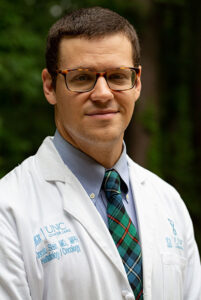Bone and Soft Tissue Cancer
Overview
At the University of North Carolina Bone and Soft Tissue Oncology Program, we strive to deliver the highest-quality, evidence-based, patient centered care to every individual who comes to see us. We believe that oncology care is best served by listening closely to our patients, understanding their values and preferences, and integrating those priorities into our approach to treating their cancer. We see cancer care as a journey, and we view our patients as partners on that journey, walking the path side by side.
Diseases
We treat a wide range of cancers that are encompassed within the umbrella of sarcoma. These include many different subtypes of cancer arising from bone, muscle, blood vessels, fat, and connective tissue.
These include:
- Angiosarcoma
- Chondrosarcoma
- Desmoplastic Small Round Cell Tumors (DSRCT)
- Epithelioid Sarcoma
- Ewing sarcoma
- Gastrointestinal Stromal Tumor (GIST)
- Kaposi Sarcoma
- Leiomyosarcoma (uterine and non-uterine)
- Liposarcomas (dedifferentiated, well-differentiated, myxoid/round-cell, pleomorphic)
- Malignant Peripheral Nerve Sheath Tumors (MPNST)
- Osteosarcoma
- Rhabdomyosarcoma
- Synovial Sarcoma
- Undifferentiated Pleomorphic Sarcoma (UPS)
- And many more
We also treat several diseases that behave differently from traditional “cancers,” but may need active management or monitoring:
- Desmoid Fibromatosis
- Dermatofibrosarcoma Protuberans (DFSP)
- Epithelioid Hemangioendothelioma (EHE)
- PEComas (from Perivascular Epithelial Cells)
- Solitary Fibrous Tumors
- Tenosynovial Giant Cell Tumors
- Giant Cell Tumors of the Bone
Our Approach
Management of sarcomas, regardless of the specific subtype, requires multidisciplinary care. We work incredibly closely with our colleagues across several disciplines, including orthopedic surgery, surgical oncology, radiation oncology, gynecologic oncology, interventional radiology, and palliative care. We meet regularly as a multidisciplinary tumor board to review new patients or cases that would benefit from several providers perspectives. Good communication between these different specialties is of the utmost importance to us and to good patient care.
Our process begins with detailed pathological review by our team of expert sarcoma pathologists. As many sarcomas can be difficult to diagnose or classify, this step is critical to ensure we have the most accurate and most precise diagnosis before embarking on a treatment plan. Sometimes, this involves additional testing beyond typical pathology staining, and may include molecular testing to define the genetic profile of that specific tumor. We also review all imaging in detail with a dedicated radiologist in our tumor board meetings. As a group, we discuss the best approach to management, and collaboratively determine the ideal sequence to pursue different therapies, if multiple treatments are needed.
Treatments may include
Surgery
Surgery done by sarcoma specialists in orthopedics or surgical oncology depending on the site of disease, sometimes done with multiple surgeons in collaboration.
Radiation
Radiation may include longer courses of high intensity radiation either before or after surgery, or shorter targeted treatments called stereotactic radiation (SBRT).
Chemotherapy
Many drugs can be used to treat sarcomas, some of the most common agents include doxorubicin, ifosfamide, gemcitabine with or without docetaxel, eribulin, and trabectedin. These drugs may be used alone or in combination.
Targeted Therapy
Several sarcoma subtypes have specific drugs that target the gene mutations that cause the cancer itself. These include imatinib (and others) for GIST, palbociclib for liposarcoma, tazemetostat for epithelioid sarcoma, sirolimus for PEComa, and pazopanib for several soft tissue sarcomas.
Immunotherapy
Activating the immune system to fight cancer is an important new way to treat cancer. It has not yet had a major breakthrough in sarcoma, but can be useful in some cases, such as angiosarcoma, alveolar soft part sarcoma, or UPS.
Clinical Trials
we have several clinical trials available at our center, and we offer these treatments for patients when they are indicated and patients are eligible.
Palliative Care
management of symptoms from cancer and side effects from treatment are critical to maintaining good quality of life with cancer. We work side by side with our palliative care providers to ensure symptoms are consistently addressed at every phase of cancer care
Adolescent and Young Adult Care
Some sarcomas can occur in young children, such as osteosarcoma, rhabdomyosarcoma, and Ewing sarcoma. These can occur in teenagers and young adults as well, at which point we may care for them in our adult cancer center. We know that the needs of young people with cancer can be quite different from older adults, and we view meeting those needs as a high priority at our institution. We have a novel collaborative care model for young adults with cancer built around a team approach, including the medical oncologist, a social worker with expertise in caring for younger folks, a pediatrics-trained palliative care physician, and specific support from pharmacy, patient navigation, a fertility specialist, and others. We acknowledge the immense challenge of facing cancer as a young person, and we strive to meet the often complex and highly individual needs of our younger patients.
Who We Are
-
Assistant Professor of Medicine
Assistant Professor of Medicine

